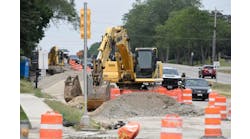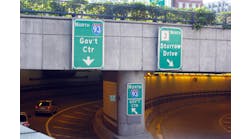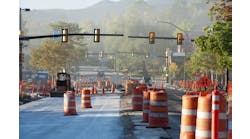The city of New York’s High Performance Infrastructure Guidelines: Best Practices for the Public Right-of-Way takes a fresh look at the conventional design and construction of public roadways: the familiar urban cross section of sidewalk, street trees, parking and travel lanes, and associated subsurface utility and storm-water infrastructure.
The publication describes 56 best practices for use by planners, civil engineers and landscape architects, each based on the core principles of sustainable design: using materials, energy and resources more effectively; limiting hazardous substances and waste; and reducing other detriments to the air, water and soil. Moreover, the practices embrace many key principles of restorative design. These include the cleansing and infiltration of storm water, increasing the cooling effects of the urban trees and other vegetation and, by enhancing the walkability of streetscapes, improving public health, safety and quality of life.
Building off buildings
Infrastructure Guidelines provides a logical complement to an earlier NYC publication: the 1999 High Performance Building Guidelines, also envisioned by the author of this story, then Department of Design and Construction (DDC) assistant commissioner. Collaboratively produced by the Design for Public Space and the DDC, Building Guidelines has served as a framework for incorporating sustainable practices into more than 40 public-building projects throughout the five boroughs—from libraries to courthouses, cultural institutions and correctional facilities among many other building types. This manual helped spur comparable green construction initiatives both locally and nationally. It is hoped that Infrastructure Guidelines will have a similar wide-reaching influence.
Infrastructure Guidelines envisions how the city might transform the way it conceives, constructs and maintains its largest real-estate holding, namely its 20,000 lane-miles of right-of-way—an aggregate area greater than the island of Manhattan. The project was driven by some initial questions: How might this ordinary real estate, designed differently, contribute to the social, economic and environmental well-being of cities? What kinds of benefits could be gained from even small improvements made across time and at this considerable scale?
Developed for use as many municipalities commit to future infrastructure upgrade and reconstruction, this manual has assembled a range of progressive practices in one place, illustrating measures incorporated in both precedent-setting programs and individual projects from around the country dealing with urban ecology. Descriptions of Philadelphia’s transformation of vacant lots into “storm-water parks” (mitigating combined sewer overflows), Seattle Public Utility’s Street Edge Alternative program and Chicago’s roof and street greening efforts exemplify these greened infrastructure trends. So do the context-sensitive designs of NYC’s Rte. 9A (former West Side Highway) and the Staten Island “Bluebelt”—ecologically sound storm-water infrastructure constructed for one-third of that borough’s area.
City of harmony
Infrastructure Guidelines promotes an interdisciplinary approach to planning and coordinating efforts to improve the sustainability of streetscape design, construction, operations and maintenance. The best practices are grouped according to key chapter headings: Streetscape, Pavement, Utility, Stormwater Management and Landscape, with sections on Site Assessment and Construction Practices. Each best practice enumerates overall objectives, benefits and limitations and lays out various technical strategies, complete with references and examples of successful precedents.
Infrastructure Guidelines addresses both independent component optimization and large-scale integrated design, describing both small- and large-scale methods for cities to use in developing infrastructure that promotes harmony and synergy with the natural environment, resulting in improved ecological productivity and better public health.
Best-management practices are placed in context with a discussion of how cities execute capital infrastructure projects. This section recommends that sustainable practices be scoped, budgeted for, planned and coordinated in a series of multiple-stakeholder and interagency working sessions beginning at the earliest stages. The guidelines also provide an invaluable planning tool for current and future business-improvement districts (BIDs) as well as block associations working in public-private-partnership arrangements with a municipality to help maintain these improvements.
Green patches
The following best practices serve to illustrate some of the synergies and benefits of high-performance infrastructure:
Improving streetscape geometries
The guidelines describe streetscapes that optimize nonvehicular circulation by reducing road width, better balancing the needs of pedestrians, the disabled, bicyclists, mass-transit users and automobiles. By listing techniques for improving intersections (using bollards, curb extensions, ADA-compliant pedestrian ramps and other methods) and discussing the application of area-wide traffic calming and management plans, the guidelines help cities improve these public zones for all user groups.
Maximizing pavement albedo
Lightening the color of asphalt and concrete on streets and sidewalks and using whiter-colored sand or aggregate, supplementary cementitious materials, light-colored binders, and sealants or paint materials helps lower pavement heat stress, increasing its life span. These measures effectively reduce high cumulative summertime temperatures (the urban heat island effect) that contribute to ozone-related respiratory and other public-health problems. At the same time, greater reflectivity of the pavement augments streetscape illumination at night.
Using recycled and reclaimed materials
Raising the percentage of recycled content in asphalt for street pavement diverts reusable materials from landfills and conserves virgin resources. Recycling concrete by crushing it on-site for use as new aggregate reduces costly transportation and environmental costs. Supplementary cementitious materials such as granulated blast-furnace slag (a by-product of iron manufacturing) or coal fly ash (a waste product from power plants) can partially substitute for portland cement in concrete, itself a high-embodied-energy material. Some of these additives also serve to raise the albedo of concrete pavement. Other waste products such as crumb rubber from tires, added as a wearing course, increases pavement life span by resisting rutting and cracking, while also reducing traffic noise.
Including vegetated filters and buffer strips
In sidewalks and medians, or at lane edges, placement of pervious pavement, gravel or vegetated areas can act to filter and clean storm water en route to its downstream treatment. These planted edges add aesthetic enhancement and improve biodiversity.
Using structural soils and continuous street tree trenches
An engineered mix of load-bearing stone in a matrix of organic soil material improves the health and life span of urban trees. Continuous trenches connecting street trees under sidewalk paving gives tree roots room for growth, while minimizing their potential damage to the pavement above. Voids in the matrix also provide a valuable reservoir for irrigation by capturing storm water.
Incorporating biointensive integrated pest management
Replacing chemical pesticides in urban vegetation with the botanical insecticides and alternatives such as soaps and bacterial preparations can effectively control pests and invasive species.
Using trenchless technologies
Inspection, diagnostics and repair of utility infrastructure may be performed via noninvasive technologies such as pavement-embedded ground microphones, or using radar or sonar. Other trenchless infrastructure work that avoids excavation includes cured-in-place repair piping, horizontal drilling and hydraulic pipe jacking to install new pipe segments. These methods preserve pavement integrity, which can minimize traffic and overall environmental disruption.
Knowing the perfect place
By using best practices that treat the right-of-way as a series of interacting systems—and by planning capital improvements accordingly—cities can capture a range of environmental, social and economic benefits. These include mitigation of the urban heat island effect, along with reduced heat stress on pavement. Streetscape improvements resulting in reduced vehicle-miles traveled can substantially reduce greenhouse gas emissions, which may be further mitigated through an increased urban tree canopy. Wide use of bioengineered structures can contribute to regional ecological health and productivity. Public health and economic benefits such as reduced noise pollution, reduced impact of disruptive construction and its associated congestion, increased property values and deferred or avoided municipal capital costs are equally compelling to planners and citizens alike.
By assembling these progressive best practices in landscape architecture, civil engineering and utility conveyance, the guidelines particularly recognize the right-of-way as a whole system, an integration of many parts that may achieve high performance in a dense urban environment. By incorporating into engineered systems, the intelligence of natural systems, whose passive processes clean and cool air and water (using infiltration, bioretention, bioremediation and evapotranspiration), and by helping to replenish and augment plant species health and diversity, these utilitarian public works can begin to transcend their single-purpose functions. This gentle “greening of gray infrastructure” also can, over the long term, achieve a subtle but profound renaturing of the city. Locally and nationally, as we proceed with a new era of infrastructure upgrade, our goal should be to make this relatively taken-for-granted real estate more resilient, functional and beautiful and to foster a healthier urban environment.


